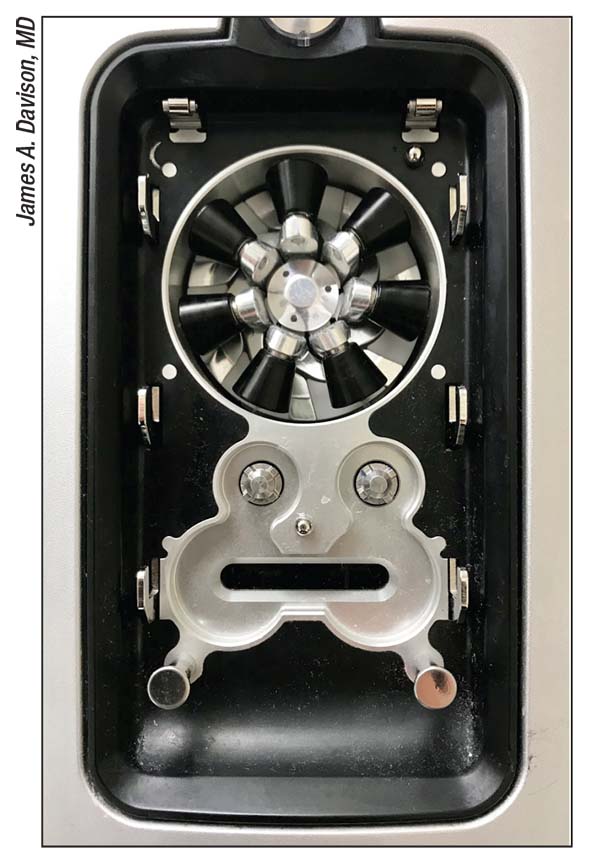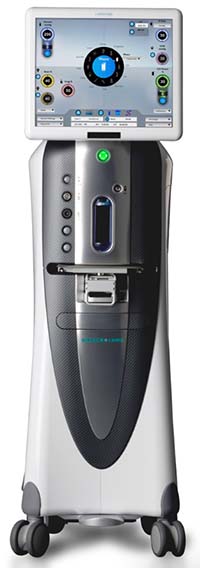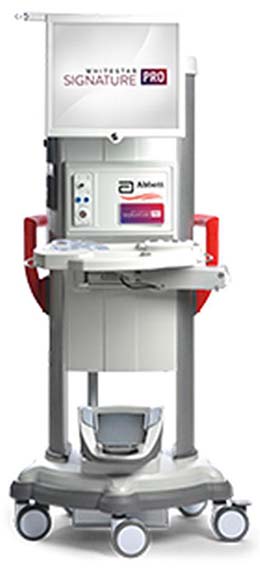Phaco recently turned 50. During these 50 years, phaco machines have undergone hundreds of incremental upgrades that have improved the safety and efficacy of cataract surgery. Today’s phaco machines offer advanced fluidics, IOP control, and anterior chamber stability. Here’s a review of the technology.
Centurion
The Alcon Centurion was introduced in 2013; the company says that it automatically and continuously adapts to changing conditions within the eye, provides anterior chamber stability during each step of the surgery, and offers optimized energy technology through enhanced fluidic management and surgical precision.
Centurion combines multiple intelligent phaco technologies and other key features, including Active Fluidics Technology, Balanced Energy Technology and Applied Integration. Active Fluidics is an automated system that optimizes anterior chamber stability by allowing surgeons to proactively set and maintain a target IOP during cataract removal. Balanced Energy enhances phaco efficiency through OZil Intelligent Phaco (IP) and the Intrepid Balanced Tip probe. Applied Integration allows the new system to be seamlessly integrated with multiple cataract surgical technologies, such as Alcon’s LuxOR surgical microscopes with Q-VUE 3-D assistant and the LenSx Laser.
 |
| Centurion peristaltic pump, with seven spring-loaded rollers and torsional rotary vent valves. |
James A. Davison, MD, who is in practice in Des Moines, Iowa, comments on moving from an earlier-generation machine to the Centurion. “When you first start using the Centurion, you discover two huge improvements that you’ve never experienced before: tremendous emulsification efficiency and totally stable fluidics,” he says. “The 30- and 45-degree balanced phaco tips have a slight bend in them before they merge into the sharp cutting edge, which generates a unique cutting-emulsification motion that makes them glide through firm cataracts easily. Torsional tip movement with IP then enhances nuclear followability for quadrant removal. Secondly, the fluidics controls are so exact and integrated that absolute iris and chamber stability is achieved throughout all cases.”
He adds that the fluidics are much better on the Centurion than they were on the Infinity. “Because of IOP control, there are no variations in pressure and flow, and there are no iris motions as surgery proceeds,” Dr. Davison says. “Patients stay well-dilated throughout the case.”
The Centurion also allows the surgeon to use different modes during different phases of the surgery. “With hard lenses, you want to shave material away and you want to either chop or divide-and-conquer by aspirating emulsified quadrants using foot pedal surgeon control of torsional tip oscillation and preset maximum vacuum rise times,” Dr. Davison says. “Interjected segments of longitudinal tip motion can be added at programmed vacuum levels to expedite material removal. Occlusion surge is never an issue because of programming and the 150-µm ABS opening drilled into the phaco tip; because of that, total occlusion never occurs. However, with softer lenses, you can program a mode in which your foot pedal controls vacuum and flow just like it does during I/A, with a specified amount of torsional tip movement added once a preset amount of maximum vacuum has been achieved. I call this ability ‘two-speed phacoemulsification’ because it’s like having two gears in a car. I might change speeds four or five times in one softer case, while I might not change them at all in a harder one,” he adds.
Newer phaco technology also may be a career extender. “I’m 68 now, and the microscopes and the phaco machines have gotten so much better that they allow older surgeons to work
longer,” Dr. Davison says.
Stellaris Elite
The Bausch + Lomb Stellaris has been available for many years, and the Stellaris Elite became available in 2017. The Elite offers multiple innovations over past iterations, including Adaptive Fluidics, Attune energy management, and eyeTELLIGENCE. The company says that these improvements are designed to work synergistically to deliver responsiveness and optimize control.
“I’ve used the Stellaris for many years, and now, with Elite, I’ve seen both efficiency and safety improvements in my hands,” says I. Paul Singh, MD, who is in practice in Kenosha, Wisconsin. “As surgeons, we want a controlled environment in the eye. We want chamber stability, followability and cutting efficiency. The Stellaris offers all of these. The Elite’s vacuum-based system allows for linear control of flow and vacuum, as well as Dual-Linear control, providing simultaneous control of irrigation, ultrasound and aspiration. As you press down on your foot pedal, you are linearly increasing the amount of followability, giving you control of the lens pieces that are coming to the tip and engaging ultrasound at any
vacuum level.”
Stellaris Elite incorporates Adaptive Fluidics, which allows surgeons to maintain chamber stability at a high level of vacuum. This feature combines precise aspiration control with predictive infusion management. It’s a pressurized fluid delivery system that modulates fluid pressure in response to the aspiration vacuum the surgeon commands. “It can, in real time, measure the vacuum and can increase flow rate as needed. It keeps the flow rate above a certain threshold, so we can decrease the chances of post-occlusion surge. When a surgeon gets a piece of nucleus in the phaco tip and lets go, the chamber doesn’t flatten or shallow. Adaptive Fluidics also gives the surgeon the ability to raise the IOP as high as 150 mmHg during surgery. This can help expand eyes with shallow anterior chambers or chambers subject to high posterior pressure. This vacuum control also allows for efficient removal of post-femtosecond-laser-treated lenses. As a glaucoma specialist, I see a lot of hyperopic, shallow eyes, and those with pseudoexfoliation and weak zonules. With Adaptive Fluidics and Dual-Linear control, adjusting fluidics based on vacuum in real time provides rock-solid chambers during surgery,” Dr. Singh adds.
 |
Additionally, the Stellaris Elite provides a six-crystal, 28.5-kHz handpiece frequency that its maker says balances mechanical cutting with acoustic cavitation. “The most efficient way of creating cavitation is dependent on the length of each stroke and how fast the needle goes back and forth. Cavitation allows for the mechanical disruption of the nuclear fragments,” Dr. Singh explains. The speed of 28.5 kHz provides the most efficient cavitation profile for efficient lens removal, users say.
“It has an incredibly efficient cutting speed; the cutting is fantastic,” Dr. Singh says. “It also has a MICS microincision phaco tip, which fits through a sub-2-mm incision,” he says.
The Stellaris Elite continues to provide excellent followability, Dr. Singh avers. “The Attune energy management system truncates the front and back part of the sound wave, allowing for high efficiency and less wasted energy,” he explains. “In multiburst mode, when you push down on the foot pedal, you keep the phaco power the same but change the amount of time it stays on. This allows the pieces to come to the tip and stay there. The environment is very stable and controlled,” he adds.
Stellaris Elite has also recently teamed up with IBM to offer
eyeTELLIGENCE, which is a first-in-class set of applications leveraging the IBM cloud on Stellaris Elite, designed to provide expedited technical support and improved workflow for eye surgeons. “From a surgeon’s perspective, it saves his or her settings,” Dr. Singh says. “If you go to a different hospital that has Stellaris Elite, you can log in with your app, and it will bring in your settings that you’ve saved to the cloud. So, you can go from place to place and it will remember you and your settings.”
EyeTELLIGENCE can also be helpful from a servicing perspective, B+L says. It can save all of the information from your cases, so that, if you feel something isn’t working right, a tech specialist can view the system remotely and implement any corrective actions with the system or settings. This may save a service call to the hospital or ambulatory surgery center to see if there’s a problem, which can save time and money.
Additionally, researchers are currently working on a smartphone app to track surgeon outcomes. “I would be able to look at my last 500 cases and see my fluid usage,” Dr. Singh says.
Whitestar Signature Pro
The Johnson and Johnson Vision Whitestar Signature Pro system offers proactive IOP management with automatic occlusion sensing. It continuously monitors IOP and proactively adjusts to maintain pressures. Additionally, it monitors vacuum levels throughout the case; optimizes power settings for enhanced control and improved efficiency; anticipates pressure changes and proactively responds to occlusion breaks; and protects the chamber during post-occlusion surge.
It offers on-demand fluidics with peristaltic, venturi or combination pump capabilities. Peristaltic offers holdability and intraoperative control, while venturi offers followability and improved efficiency; on-demand transition provides efficiency throughout the procedure. “It’s customizable to you, rather than you being customizable to it,” says Sumit (Sam) Garg, MD, who is in practice in Irvine, California. “If you’re a peristaltic surgeon, you can use peristaltic. If you’re a venturi surgeon, you can do venturi. If you want to use both on the same case, you can do that.”
Ultrasound with the Ellips FX handpiece balances power and control, the company says. “With the handpiece, we’re not restricted to a certain type of phaco needle or sleeve size,” explains Dr. Garg. “We can use smaller incisions or larger incisions. We can use a curved tip or a straight tip. We can customize these aspects to whatever we are most comfortable with.”
 |
He adds that the Signature Pro provides a very stable chamber and a really quick response when it comes to surge. “It senses at a rate designed to provide the fastest compensation for any surge that may occur,” Dr. Garg says. “It also has a setting that can check for occlusion. When it feels like [the occlusion is] going to break, it automatically ramps down the vacuum so that you avoid surge. Additionally, it works well across a spectrum of cataract grades.”
Dr. Garg uses a femtosecond laser in 20 to 30 percent of his cases, and he says the venturi pump works well with femto. “You’re basically doing vacuum-assisted removal of the lens at that point, with bursts of phaco as needed because the lens has already been pre-fractionated by the femtosecond laser,” he explains.
Additionally, the system has an app that syncs wirelessly to the phaco unit, so surgeons can download the metrics of their case, such as energy usage and operation time. “You can even use it to track flow within the OR and measure turnover time,” Dr. Garg says.
“Johnson and Johnson has improved chamber stability by adapting a lower-bore, less-compliant tubing, which is important with regard to safety,” Dr. Garg adds. You can operate in the bag or at the iris plane and be assured that the chamber is going to stay quite stable.”
The Future
Carl Zeiss Meditec recently purchased IanTECH, which is currently developing a new phaco machine. “It will probably be introduced next year, and it’s pretty wild,” Dr. Singh says. “It basically takes all the brains we have in the big console and puts them all in the handpiece. There’s no longer going to be a big console or foot pedal. All controls are in the handpiece. It’s a whole different way of approaching phaco. It has no cavitation creation, so no heat is generated, and it has a different way of breaking up the nucleus. It’s going to be interesting to see how that changes what we’re doing.” REVIEW
Dr. Davison is a consultant to Alcon, Dr. Singh is a consultant to Bausch + Lomb and Dr. Garg is a consultant to Johnson & Johnson Vision.



